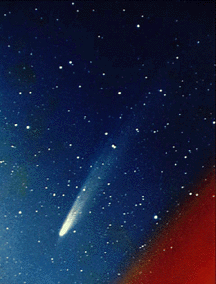This is an image of Comet Kohoutek.
Click on image for full size
NASA
Comets
Not too long ago, many people thought that comets were a sign that something
terrible was about to happen. People didn't
understand about how objects in the sky moved, so the sight of a comet must have been very scary.
Now we know that comets are lumps of ice and dust that come flying into the solar system from deep space, and that some comets make repeated trips. Jets of gas and dust form long
tails that we can see from Earth. These tails can sometimes be millions of miles long.
Unfortunately, we don't get to see comets very frequently.
In 1985-1986, a spacecraft called Giotto visited the most famous comet of all,
Halley's comet. In 1994, a comet named Shoemaker-Levy, ran into Jupiter!
In 1996 and 1997, we could see comet Hyakutake, and comet Hale-Bopp from Earth. Hale-Bopp was one of the brightest comets ever seen from Earth. Comet Linear was discovered in 1999 and came closest to the Sun in July 2000. The Stardust spacecraft flew by Comet Wild 2 in January 2004, collecting samples of the comet to return to Earth. The newest comet mission is Rosetta and it will land on a comet named Churyumov-Gerasimenko
Now scientists have identified a class of comets known as small comets (though they originally were just called snowballs from space!).
How would you like build your own comet? Now you can, with our interactive comet animation. Check it out!
You might also be interested in:
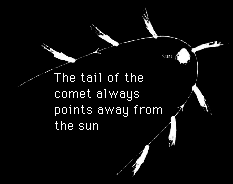
When comets are kicked out of the Oort Cloud, they begin a passage into the solar system, spinning and tumbling as they come. As the comet comes closer to the sun, near the region of space occupied by
...more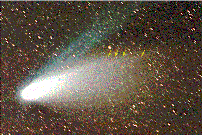
Comet Hale-Bopp was one of the brightest comets of all time. Astronomers witnessed the comet spew out intermittent bursts of dust. The surface seemed to be an incredibly dynamic place, with 'vents' being
...more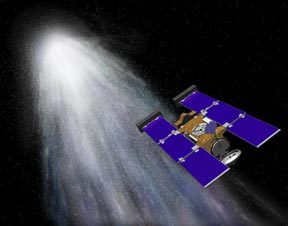
Stardust is the name of a space mission that studied a comet. Stardust flew very close to the comet in January 2004. It took some very good pictures of the nucleus of the comet. It also grabbed some dust
...more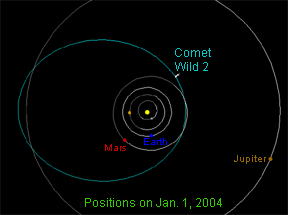
Comet Wild 2 is named after the scientist who discovered it. Paul Wild is an astronomer from Switzerland who discovered the comet in January 1978. Wild 2 is pronounced "Vilt 2". It takes the comet a little
...more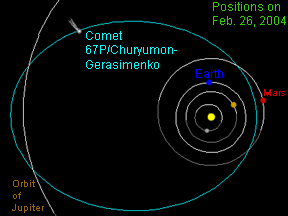
Comet Churyumov-Gerasimenko was discovered in 1969. It is named after the two scientists who found it, Klim Churyumov and Svetlana Gerasimenko. The comet goes around the Sun once every 6.57 years. The
...more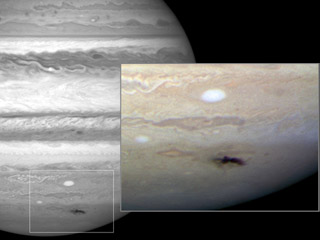
Anthony Wesley is an astronomer in Australia. One night in July 2009, Wesley noticed a dark spot on Jupiter that hadn't been there before. He had discovered the remains of a huge impact on Jupiter! A comet
...more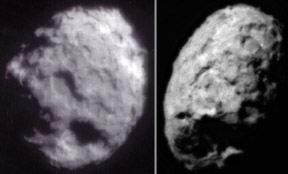
The pictures on this page show the nucleus of a comet. These are the best pictures ever made of the nucleus of a comet. The nucleus of a comet is a big lump of ice and dust. This one is about five kilometers
...more


